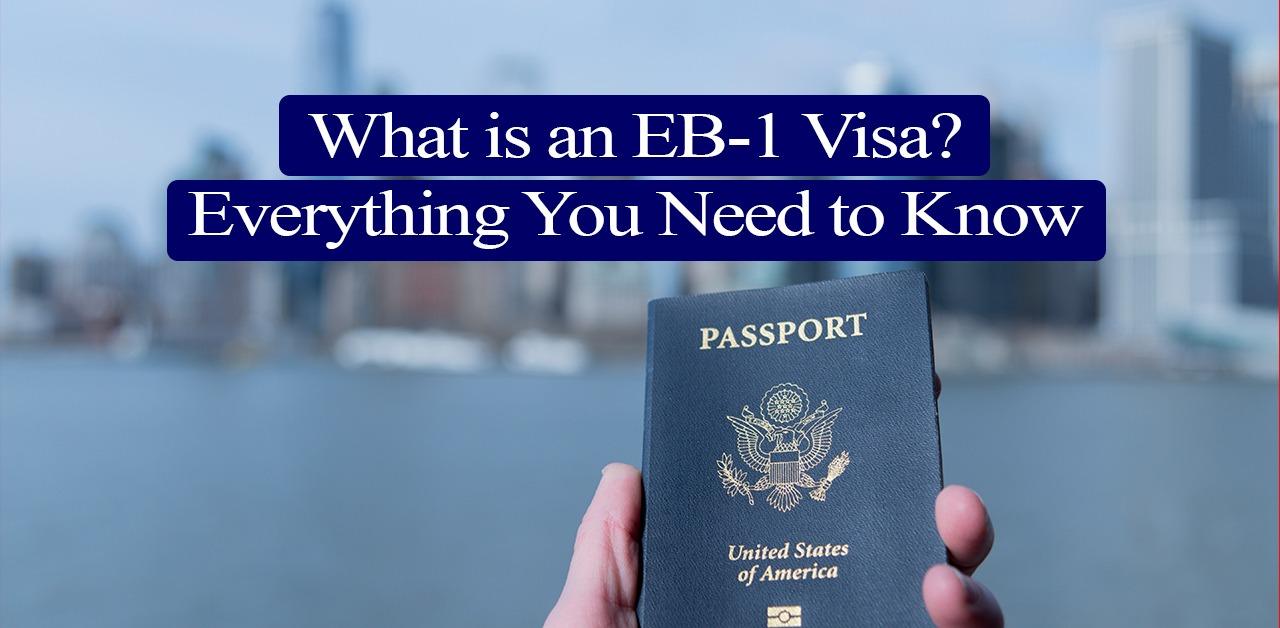The EB1 visa category is among the most sought-after employment-based visas in the United States. Often referred to as the “Einstein Visa,” the EB-1 Visa is designed for individuals who are at the top of their respective fields. Whether you are a groundbreaking researcher, an award-winning artist, or a top-tier executive, this visa category recognizes and welcomes extraordinary talent.
But what is the EB-1 Visa, and how can one obtain it? In this guide, we’ll break down the essential details of the EB-1 visa, including its different subcategories, key requirements, the steps involved in the application process, and the cost. This information will help you understand this respected immigration option more clearly.
What Is An EB1 Visa: Definition and Purpose
The EB-1 Visa is a premier employment-based first-preference visa that allows skilled professionals to live and work permanently in the United States. The U.S. Citizenship and Immigration Services (USCIS) has established a tiered system for employment-based visas, categorized into five preference levels from EB-1 through EB-5. The EB-1 visa category is designed for individuals who have received a job offer from a U.S. company (except for the EB1A subcategory) and wish to establish their permanent residence there. The EB-1 Visa is ideal for those with extraordinary ability in their field. In the context of the EB-1 Visa, “Extraordinary Ability” means you have achieved a level of expertise that places you at the top of your field.
This category targets individuals with national or international recognition in their field. The goal is to attract top talent from around the world in areas like science, arts, business, education, or athletics, helping the United States stay competitive on a global scale. Hence, the EB-1 visa category is designed for:
- Individuals with extraordinary abilities in the field of sciences, arts, education, business, or athletics
- Outstanding professors and researchers
- Multinational executives or managers
EB-1 visa: Three Subcategories
The EB-1 visa is divided into three subcategories, each tailored to specific groups of exceptional individuals. Explore these EB-1 categories to find the one that matches your skills and qualifications and take the first step toward U.S. permanent residency.
EB-1A: Extraordinary Ability
This category is for individuals with exceptional skills and achievements in fields like science, arts, education, business, or athletics. It recognizes individuals with sustained national or international acclaim who are at the top of their field.
Key Requirements
- You must either demonstrate extraordinary ability with evidence of one-time major achievement (e.g., Pulitzer, Oscar, Olympic Medal) or meet at least 3 out of 10 criteria defined by USCIS (e.g., original contributions, memberships, publications, awards, etc.)
- Show recognition and prominence in your field of expertise.
- Provide evidence of extensive documentation highlighting their achievements.
Who Can File the EB-1A Visa Petition?
Unlike the other two sub-categories, you can apply for an EB-1A visa by self-petitioning. The visa does not require a job offer, so no employment certification is required.
Curious if you qualify? Click here for a free evaluation.
EB-1B: Outstanding Professors and Researchers
This category is for internationally recognized professors or researchers who have made significant contributions to their academic field. It is intended for those pursuing a permanent position in teaching or research in the U.S.
Key Requirements
- International recognition for outstanding achievements in a specific academic field.
- At least 3 years of teaching or research experience.
- Have a job offer for a tenured, tenure-track, or comparable research position in the U.S.
- Evidence such as authored publications, peer-reviewed research, or membership in prestigious academic organizations.
Who Can File the EB-1B Visa Petition?
Unlike an EB-1A visa, your prospective U.S. Employer must provide an offer of employment and must fill out an I-140 form for you. You are not allowed to self-petition.
EB-1C: Multinational Managers or Executives
This category is for executives or managers of multinational companies who are transferring to the U.S. to work in a similar capacity for their employer’s U.S.-based operations.
Key Requirements
- The individual must have been employed in a managerial or executive role in the foreign company for at least one continuous year within the past 3 years before filing the EB1C petition
- The U.S. employer must have a qualifying relationship (parent, affiliate, or subsidiary) with the foreign company.
- Must have a full-time job offer to work for a U.S. company in a managerial or executive capacity and seek to enter the United States to continue working as a manager or executive for the same or a connected firm.
Who Can File the EB-1C Visa Petition?
Like the EB-1B visa, your potential employer must act as your petitioner.
Check your eligibility and approval probability here!
Why You Should Choose the EB1 Visa?
If you qualify for any of these categories, consider applying for an EB1 visa, which offers numerous advantages like:
- Faster Processing: EB-1 visas are usually quicker to process than other types of visas because they don’t typically require a PERM labor certification from the U.S. Department of Labor, which usually takes 2+ years.
- Fastest Path to Citizenship: After holding the EB-1 green card for 5 years, you can apply for US citizenship.
- Family Reunification: The EB-1 visa allows your immediate family members—your spouse and unmarried children under 21—to obtain green cards along with you under the E-14 or E-15 immigrant status.
- Career Freedom: You can establish your own company or be employed on an EB-1 visa.
- Freedom to Live and Work in the U.S.: EB-1 visa grants the ability to live and work anywhere in the United States.
- Fair assessment: EB-1 visas are based on the applicant’s merits, not on the green card lottery or family-based green cards.
- International Travel: Enjoy the flexibility to travel freely in and out of the U.S
- Self-Petition Option (for EB-1A): Applicants can file without employer sponsorship, making it ideal for independent achievers.
How to Apply for an EB-1 Visa: Step-by-Step
This step-by-step guide will give you an overview, ensure you understand the process, and help you stay organized during your EB-1 visa application.
- Gather Supporting Evidence: after identifying which EB-1 category (EB-1A, EB-1B, or EB-1C) you qualify for based on your achievements and credentials, gather supporting evidence to demonstrate your extraordinary ability, outstanding academic contributions, or managerial/executive experience.
- File Form I-140 (Immigrant Petition for Alien Worker): Submit Form I-140, along with supporting documents, to U.S. Citizenship and Immigration Services (USCIS). If you are self-petitioning under EB-1A, you file the petition yourself. Otherwise, your employer files on your behalf (EB-1B or EB-1C). Ensure your application is well-documented to meet USCIS criteria.
- Apply for Adjustment of Status or Embassy Processing: Depending on your location, you can apply for Adjustment of Status (If in the U.S.) or Consular Processing (If Outside the U.S.).
If you are already in the U.S., file Form I-485 (Application to Register Permanent Residence or Adjust Status) to transition to a green card. Submit additional documents, such as medical exams and biometrics. If you are applying from outside the U.S., you’ll go through consular processing at a U.S. Embassy or Consulate. Attend an interview and provide the required documentation. - Biometrics Appointment and Medical Examination: You might have to go to a biometrics appointment to give your fingerprints, photos, and signatures, as well as an immigration medical examination as part of the procedure.
- Attend Visa Interview: Attend the visa interview with a consular officer from the USCIS.
- Receive Your Visa Approval: If your application is accepted, you will be granted an EB-1 visa, which will enable you to reside and work in the United States.
What is the Processing Time for an EB-1 Petition?
The processing time for EB-1 petitions varies by category and the beneficiary’s location. Processing time is much faster if you are applying from within the USA since you can concurrently file your petition and green card application. However, concurrent filing is not applicable for consular processing.
For beneficiaries within the USA, EB-1A petitions typically take 8–12 months, while EB-1B petitions are processed within 7–12 months. The processing time ranges from 7 to 12 months for EB-1C petitions.
With premium processing, petitions are typically processed significantly faster than the standard timeline, within 15-45 days.
EB-1 Visa Cost
Here’s a basic breakdown of the current filing fees for the EB-1 visa.
For applicants filing from within the U.S.:
Form I-140, the petition for an employment-based immigrant visa:
- Filing Fee: $715. This fee is paid by the petitioning employer, if not a self-petition.
- For Premium Processing (Optional), the USCIS Fee is $2,805.
Form I-485, the application to adjust status for people who already live in the U.S.:
- Green Card application (I-485) filing fee: $1440
- Advance Parole/Travel permit (I-131) filing fee (optional): $630
- Work Authorization (I-765) filing fee (optional): $260
For applicants applying from outside the U.S.:
Form I-140, the petition for an employment-based immigrant visa:
- Filing Fee: $715. This fee is paid by the petitioning employer, if not a self-petition.
- For Premium Processing (Optional), the USCIS Fee is $2,805.
Form DS-260, the online application for an immigrant visa through consular processing:
- Filing Fee: $345 for each applicant
There might be additional fees involved for asylum programs, medical reports, green card issuance etc.
While the costs associated with the EB-1 visa process may seem significant, they represent an investment in a streamlined and efficient pathway to U.S. permanent residency. Unlike many other visa categories, the EB-1 visa bypasses the lengthy labor certification process, making it a faster and more accessible option for qualified individuals.
This visa not only opens doors to living and working in the United States but also provides the freedom to travel internationally and the opportunity to reunite your family in a new chapter of your life. By choosing the EB-1 visa, you are investing in a future filled with professional growth, personal opportunities, and the chance to make a lasting impact in your field.
Hence, if you meet the qualifications, now is the time to take the first step toward your brighter future. Contact an immigration expert today to explore your eligibility and start your journey to permanent residency. We are excited to support you to achieve your dreams in the United States!
Frequently Asked Questions
Is EB-1 the same as a green card?
The EB-1 visa and a green card are closely related but not exactly the same. The EB-1 is an employment-based immigrant visa that serves as a pathway for eligible individuals to apply for a green card. Once approved, you can live and work permanently in the United States. Think of the EB-1 visa as the first step toward obtaining a green card to achieve permanent residency in the U.S. quickly and efficiently.
Can I travel outside the U.S. while my EB-1 application is pending?
Yes, it is possible to travel internationally while your EB-1 application is being processed. However, if you are in the process of adjusting your status by filing Form I-485, you must apply for an Advance Parole document before traveling. This document ensures you can re-enter the U.S. without complications or risk of abandoning your application. Failing to secure Advance Parole could lead to delays or denial of your adjustment of status.
Can I change employers or positions after receiving the EB-1 visa?
The ability to change employers or positions after receiving an EB-1 visa depends on the circumstances. For EB-1B (Outstanding Professors or Researchers) and EB-1C (Multinational Managers or Executives), the visa is typically tied to the sponsoring employer and the specific role mentioned in the petition. However, in some cases, changes may be allowed if the new position aligns with your approved EB-1 category. For EB-1A (Extraordinary Ability) recipients, who self-petitioned, there is more flexibility to change employers or work independently since the visa isn’t tied to a specific employer.

